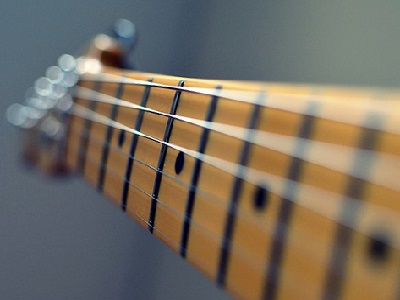Eliminate Fret Buzzing Problems Once And For All
 So there you are, playing your favorite lick when all of a sudden you hear a light rasping. You’re all alone, no one else is around, and so you tilt your head closer to the guitar. And then it happens again, as soon as you play your note –the buzz.
So there you are, playing your favorite lick when all of a sudden you hear a light rasping. You’re all alone, no one else is around, and so you tilt your head closer to the guitar. And then it happens again, as soon as you play your note –the buzz.
This isn’t a horror story, although fret buzzing can be a horrible annoyance.
So What Causes Fret Buzzing, And How Do We Fix It?
Fret buzzing can be caused by a number of things. The first is improper string gauge. Believe it or not, certain tuning requires one of two things; either a certain string gauge, or a certain action height.
This means that if you are simply tuning your set of 9’s up and down and up and down, you aren’t tuning correctly. Lower tuning requires thicker strings, and we suggest that you use a string gauge calculator online to find the proper gauging for your strings.
But what if you have properly gauged string? Is the world of buzz-less notes as you note it at an end?
Not quite. Another factor that can contribute to string buzzing is string height. String height, as the name suggests, is how high off the fret board your strings are suspended. Strings that are too low will buzz.
Strings that are too high will be too hard to press down and may cause wrist injuries. The best way to achieve proper string height is to measure. The most common guitar string height for guitarists is 3/64” and is achieved by adjusting the saddle and measuring at the twelfth fret.
NEVER Adjust By Extreme Increments!
We cannot stress enough how important it is to gradually lower your bridge height. Lowering one side too much can cause the neck to warp out a bit. This is bad. Adjusting also means that you will need to reset your intonation.
Okay, so my strings are gauged properly, my string height is 3/64”, and yet my string is still buzzing. What did I do wrong?
Nothing. In fact, you just diagnosed your first guitar problem. If your string is still buzzing after a complete setup and a set of properly gauges strings, it is due to something called your truss rod. The truss rod is a rod that is in your guitar’s neck.
Where And How to Locate the Truss Rod
The way to reach the truss rod is at the headstock. There is a little plate on your headstock just beneath the strings. This is the truss rod cover. There are different types of truss rods (some are screwdriver headed and some are Allen wrench headed) but they are all adjusted the same; lefty loosey, righty tighty.
Just like your bridge, the truss rod needs to be adjusted slowly, in minimal increments. Before adjusting, look down the length of your neck. You may notice a slight bow in your neck. Slowly adjust the truss rod, using tiny turns, and keep checking until the bow is gone.
Your buzz should be gone.
If you have problems after all of this, it is best that you take your guitar to a technician as there may be build issues with your guitar. Likewise, if you are uncomfortable adjusting your truss rod, do the same.
Get a Guitar With Better Playability And Sound Today!
The Learn And Master Guitar Setup & Maintenance course is perfect for the discerning guitarist. Within the 3 full-length DVDs you receive, you will learn everything from correctly restringing your guitar to adjusting actions, checking relief and more…







Leave A Comment